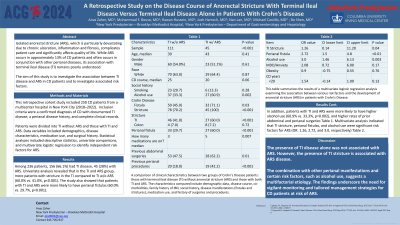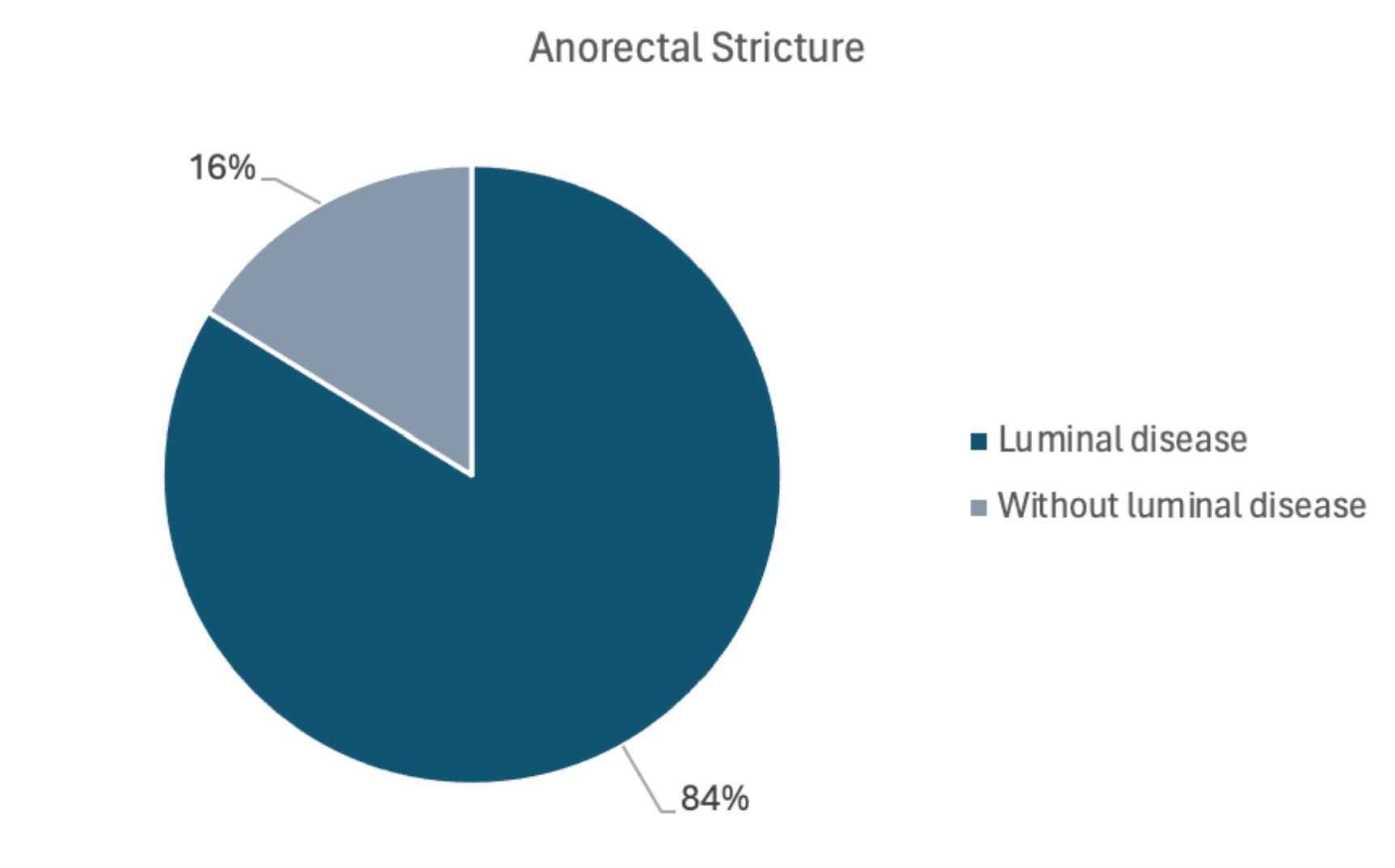Sunday Poster Session
Category: IBD
P0903 - A Retrospective Study on the Disease Course of Anorectal Stricture With Terminal Ileal Disease Versus Terminal Ileal Disease Alone in Patients With Crohn’s Disease
Sunday, October 27, 2024
3:30 PM - 7:00 PM ET
Location: Exhibit Hall E

Has Audio
- AZ
Anas Zaher, MD
New York-Presbyterian / Brooklyn Methodist Hospital
Brooklyn, NY
Presenting Author(s)
Anas Zaher, MD1, Nan Lan, MD2, Muhammad F. Bouso, MD1, Rawan Hussein, MD1, Josh Harroch, MD3, Bo Shen, MD4
1New York-Presbyterian / Brooklyn Methodist Hospital, Brooklyn, NY; 2New York-Presbyterian/Columbia University Irving Medical Center, New York, NY; 3New York Presbyterian Brooklyn Methodist Hospital, Brooklyn, NY; 4Columbia University, New York, NY
Introduction: Anorectal stricture (ARS) is a particularly morbid manifestation of Crohn’s disease (CD), resulting in a diminished quality of life related to incomplete defecation, pain, incontinence and recurrent operative interventions and the natural history of the disease remains unknown. The primary aim of the study is to evaluate ARS and terminal ileal (TI) disease associations and risk factors in CD. The secondary aim is to evaluate ARS and luminal disease associations.
Methods: This was a retrospective, IRB-approved, review of data from Columbia University (CU) between 2010 and 2023. Patient records were analyzed to include those diagnosed with TI or luminal disease (TI, ileocolic, colon or small intestine) with or without ARS, confirmed through clinical, endoscopic, and radiologic findings. Data collected included demographics (age, gender, ethnicity), co-morbidities, social history and clinical data (disease duration, complications, surgical interventions, and medication history). Patients were categorized into two groups: TI involvement with ARS versus TI alone. In addition, luminal involvement with ARS versus luminal disease alone.
Results: Among 236 patients, 156 were found to have TI involvement and 212 had luminal disease. From the TI involvement group, 45 (28.8%) had ARS compared to 111 (71.2%) without ARS, (p=0.31). Age, gender, CD course and demographics were not statistically different between the two groups. From the luminal disease group, 62 (83.8%) had ARS compared to 12 (16%) without ARS, (p=0.01). Finally, 86 patients with perianal fistula (PAF) were identified, and 39 (45.3%) were associated with ARS compared to 47 (54.7%) without ARS, (p< 0.001). Regarding PAF in patients with TI disease, 60 individuals (38.5%) had PAF compared to 96 individuals (61.2%) without it (p=0.5).
Discussion: There was no association between TI disease and ARS involvement. However, patients with luminal disease were more likely to develop ARS disease compared to those without luminal disease. Patients with perianal fistulas were more likely to develop ARS disease compared to patients without perianal fistula disease.

Note: The table for this abstract can be viewed in the ePoster Gallery section of the ACG 2024 ePoster Site or in The American Journal of Gastroenterology's abstract supplement issue, both of which will be available starting October 27, 2024.
Disclosures:
Anas Zaher, MD1, Nan Lan, MD2, Muhammad F. Bouso, MD1, Rawan Hussein, MD1, Josh Harroch, MD3, Bo Shen, MD4. P0903 - A Retrospective Study on the Disease Course of Anorectal Stricture With Terminal Ileal Disease Versus Terminal Ileal Disease Alone in Patients With Crohn’s Disease, ACG 2024 Annual Scientific Meeting Abstracts. Philadelphia, PA: American College of Gastroenterology.
1New York-Presbyterian / Brooklyn Methodist Hospital, Brooklyn, NY; 2New York-Presbyterian/Columbia University Irving Medical Center, New York, NY; 3New York Presbyterian Brooklyn Methodist Hospital, Brooklyn, NY; 4Columbia University, New York, NY
Introduction: Anorectal stricture (ARS) is a particularly morbid manifestation of Crohn’s disease (CD), resulting in a diminished quality of life related to incomplete defecation, pain, incontinence and recurrent operative interventions and the natural history of the disease remains unknown. The primary aim of the study is to evaluate ARS and terminal ileal (TI) disease associations and risk factors in CD. The secondary aim is to evaluate ARS and luminal disease associations.
Methods: This was a retrospective, IRB-approved, review of data from Columbia University (CU) between 2010 and 2023. Patient records were analyzed to include those diagnosed with TI or luminal disease (TI, ileocolic, colon or small intestine) with or without ARS, confirmed through clinical, endoscopic, and radiologic findings. Data collected included demographics (age, gender, ethnicity), co-morbidities, social history and clinical data (disease duration, complications, surgical interventions, and medication history). Patients were categorized into two groups: TI involvement with ARS versus TI alone. In addition, luminal involvement with ARS versus luminal disease alone.
Results: Among 236 patients, 156 were found to have TI involvement and 212 had luminal disease. From the TI involvement group, 45 (28.8%) had ARS compared to 111 (71.2%) without ARS, (p=0.31). Age, gender, CD course and demographics were not statistically different between the two groups. From the luminal disease group, 62 (83.8%) had ARS compared to 12 (16%) without ARS, (p=0.01). Finally, 86 patients with perianal fistula (PAF) were identified, and 39 (45.3%) were associated with ARS compared to 47 (54.7%) without ARS, (p< 0.001). Regarding PAF in patients with TI disease, 60 individuals (38.5%) had PAF compared to 96 individuals (61.2%) without it (p=0.5).
Discussion: There was no association between TI disease and ARS involvement. However, patients with luminal disease were more likely to develop ARS disease compared to those without luminal disease. Patients with perianal fistulas were more likely to develop ARS disease compared to patients without perianal fistula disease.

Figure: Pie chart illustrating the prevalence of anorectal stricture in patients with luminal disease
Note: The table for this abstract can be viewed in the ePoster Gallery section of the ACG 2024 ePoster Site or in The American Journal of Gastroenterology's abstract supplement issue, both of which will be available starting October 27, 2024.
Disclosures:
Anas Zaher indicated no relevant financial relationships.
Nan Lan indicated no relevant financial relationships.
Muhammad Bouso indicated no relevant financial relationships.
Rawan Hussein indicated no relevant financial relationships.
Josh Harroch indicated no relevant financial relationships.
Bo Shen indicated no relevant financial relationships.
Anas Zaher, MD1, Nan Lan, MD2, Muhammad F. Bouso, MD1, Rawan Hussein, MD1, Josh Harroch, MD3, Bo Shen, MD4. P0903 - A Retrospective Study on the Disease Course of Anorectal Stricture With Terminal Ileal Disease Versus Terminal Ileal Disease Alone in Patients With Crohn’s Disease, ACG 2024 Annual Scientific Meeting Abstracts. Philadelphia, PA: American College of Gastroenterology.
